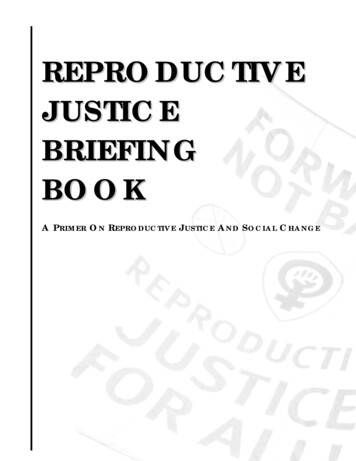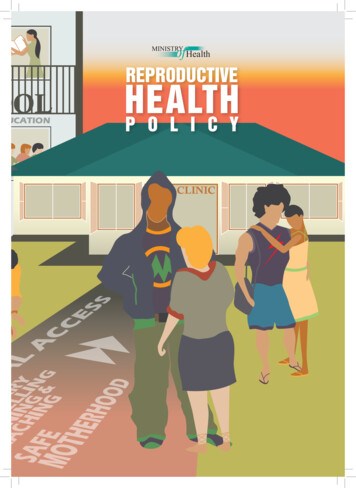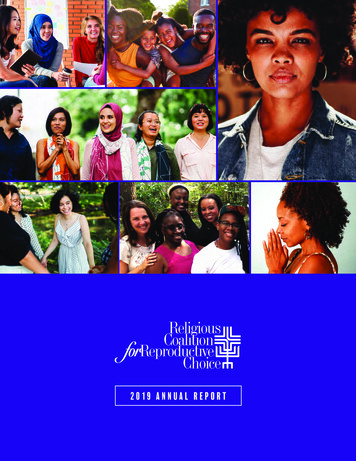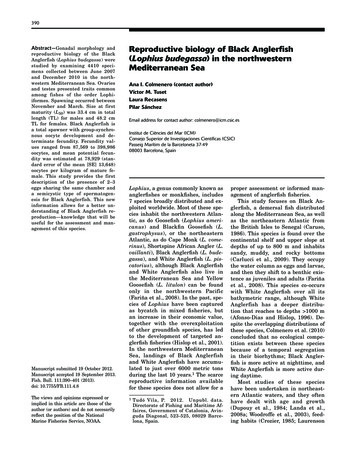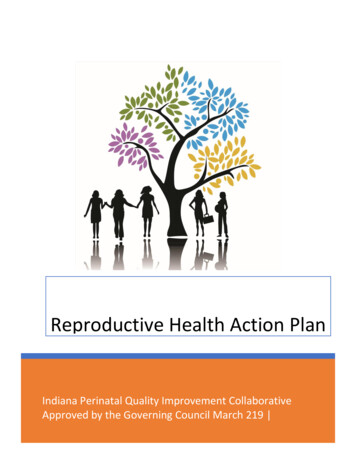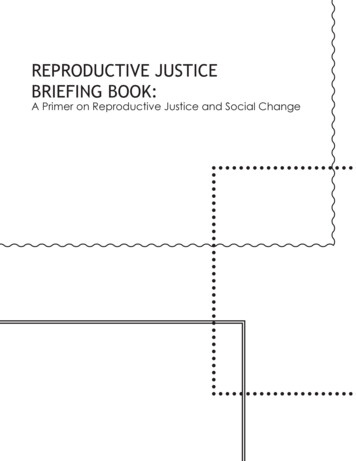
Transcription
Reproductive JusticeBriefing Book:A Primer on Reproductive Justice and Social Change
CONTENTS4 What Is Reproductive Justice?by Loretta Ross, SisterSong Women of Color Reproductive Health Collective5 Listen Up!: How to Connect with Young Women Through Reproductive Justiceby Mary Mahoney, Pro-Choice Public Education Project7 Abstinence-Only and Reproductive Injusticeby John S Santelli, MD, MPH, Rebecca Schleifer, JD, MPH and Lila J Lande, MPH8 Sex, Lies and Birth Control: What You Need to Know About Your Birth ControlCampaignby Committee on Women, Population and the Environment10 Birth Control and Gender Justiceby Cristina Page11 Pharmacists’ Refusals and Reproductive Justiceby Carole Joffe, University of California, Davis12 Abortion Rights and Reproductive Justiceby Marlene Fried and Susan Yanow14 The Hyde Amendment Violates Reproductive Justice and Discriminates AgainstPoor Women and Women of Colorby Stephanie Poggi, National Network of Abortion Funds15 Reproductive Justice and Women of Colorby Toni M. Bond, African American Women Evolving16 Reproductive Justice Issues for Asian and Pacific Islander Womenby Maria Nakae, Asian Communities for Reproductive Justice18 Reproductive Justice and Lesbian, Gay Bisexual and Transgender Liberationby Alisa Wellek and Miriam Yeung, The Lesbian, Gay, Bisexual & Transgender Community Center19 Immigrant Rights and Reproductive Justiceby Jessica Gonzalez-Rojas and Aishia Glasford, National Latina Institute for Reproductive Health20 Made in the USA: Advancing Reproductive Justice in the Immigration Debateby Priscilla Huang, National Asian Pacific American Women’s Forum22 Incarcerated Women and Reproductive Justiceby Rachel Roth23 Disabled Women and Reproductive Justiceby Mia Mingus, Georgians for Choice25 Reproductive Justice for All Pregnant Womenby Lynn Paltrow, National Advocates for Pregnant Women
26 Men and Reproductive JusticeRus Ervin Funk, MensWork: Eliminating Violence Against Women, Inc.28 Adoption and Reproductive Justiceby Laura Briggs, University of Arizona29 Foster Care and Reproductive Justiceby Dorothy Roberts, Northwestern University30 Assisted Reproductive Technologies through a Reproductive Justice Lensby the Committee on Women, Population and the Environment National Gender, Eugenics & Biotechnology TaskForce and CWPE Staff31 10 Reasons to Rethink Overpopulationby the Population and Development Program at Hampshire College32 Environmental Justice: Woman is the First Environmentby Katsi Cook, Mohawk Nation at Akwesasne34 Spirituality: A Tool to Achieve Reproductive Justiceby Emily P. Goodstein, Spiritual Youth for Reproductive Freedom35 Reproductive Justice Worldwide: Opposition to Women’s Rights at the UnitedNationsby Pam Chamberlin, Political Research Associates37 Law, Medicine and Morality: The Threat to Reproductive Justiceby Lois Uttley, MergerWatch Project39 The Incompatibility of Neo-Liberal “Choice” and Reproductive Justiceby Rickie Solinger40 ABORTION MATTERS TO REPRODUCTIVE JUSTICEby Leila Hessini, Lonna Hays, Emily Turner, and Sarah Packer, IPAS42 Conditions of Reproductive Justiceby Rickie Solinger
W H AT I SREPRODUCTIVE JUSTICE?By Loretta Ross, SisterSong Women of Color Reproductive Health CollectiveReproductive Justice is the complete physical,mental, spiritual, political, social, and economicwell-being of women and girls, based on the fullachievement and protection of women’s human rights.This definition as outlined by Asian Communities forReproductive Justice (ACRJ) offers a new perspectiveon reproductive issues advocacy, pointing out that forIndigenous women and women of color it is importantto fight equally for (1) the right to have a child; (2) theright not to have a child; and (3) the right to parentthe children we have, as well as to control our birthingoptions, such as midwifery. We also fight for thenecessary enabling conditions to realize these rights. Thisis in contrast to the singular focus on abortion by thepro-choice movement that excludes other social justicemovements.The Reproductive Justice framework analyzeshow the ability of any woman to determine herown reproductive destiny is linked directly to theconditions in her community—and these conditionsare not just a matter of individual choice and access.Reproductive Justice addresses the social reality ofinequality, specifically, the inequality of opportunitiesthat we have to control our reproductive destiny.Moving beyond a demand for privacy and respect forindividual decision making to include the social supportsnecessary for our individual decisions to be optimallyrealized, this framework also includes obligationsfrom our government for protecting women’s humanrights. Our options for making choices have to be safe,affordable and accessible, three minimal cornerstones ofgovernment support for all individual life decisions.One of the key problems addressed by ReproductiveJustice is the isolation of abortion from other socialjustice issues that concern communities of color: issuesof economic justice, the environment, immigrants’ rights,disability rights, discrimination based on race and sexualorientation, and a host of other community-centeredconcerns. These issues directly affect an individualwoman’s decision-making process. By shifting the focusto reproductive oppression—the control and exploitationof women, girls, and individuals through our bodies,sexuality, labor, and reproduction—rather than a narrowfocus on protecting the legal right to abortion, SisterSongWomen of Color Reproductive Health Collective isdeveloping a more inclusive vision of how to build a new movement.Because reproductive oppression affects women’slives in multiple ways, a multi-pronged approach isneeded to fight this exploitation and advance thewell-being of women and girls. There are three mainframeworks for fighting reproductive oppression definedby ACRJ:1. Reproductive Health, which deals withservice delivery2. Reproductive Rights, which addresseslegal issues, and3. Reproductive Justice, which focuses onmovement building.Although these frameworks are distinct intheir approaches, they work together to providea comprehensive solution. Ultimately, as in anymovement, all three components—service, advocacy andorganizing—are crucial.The Reproductive Justice analysis offers aframework for empowering women and girls relevantto every family. Instead of focusing on the means—adivisive debate on abortion and birth control thatneglects the real-life experiences of women and girls—the Reproductive Justice analysis focuses on the ends:better lives for women, healthier families, and sustainablecommunities. This is a clear and consistent message forall social justice movements. Using this analysis, we canintegrate multiple issues and bring together constituenciesthat are multi-racial, multi-generational, and multi-classin order to build a more powerful and relevant grassrootsmovement.Reproductive Justice focuses on organizing women,girls and their communities to challenge structural powerinequalities in a comprehensive and transformativeprocess of empowerment that is based on SisterSong’sself-help practices that link the personal to the political.Reproductive Justice can be used as a theory for thinkingabout how to connect the dots in our lives. It is also astrategy for bringing together social justice movements.But also, it is a practice – a way of analyzing our livesthrough the art of telling our stories to realize our visionsand bring fresh passion to our work.The key strategies for achieving this vision includesupporting the leadership and power of the most
excluded groups of women, girls and individuals withina culturally relevant context. This will require holdingourselves and our allies accountable to the integrity ofthis vision. We have to address directly the inequitabledistribution of power and resources within themovement, holding our allies and ourselves responsiblefor constructing principled, collaborative relationshipsthat end the exploitation and competition within ourmovement. We also have to build the social, political andeconomic power of low-income women, Indigenouswomen, women of color, and their communities so thatthey are full participating partners in building this newmovement. This requires integrating grassroots issuesand constituencies that are multi-racial, multi-generationaland multi-class into the national policy arena, as well asinto the organizations that represent the movement.SisterSong is building a network of allied socialjustice and human rights organizations that integratethe reproductive justice analysis into their work. We areusing strategies of self-help and empowerment so thatwomen who receive our services understand they are vitalemerging leaders in determining the scope and directionof the Reproductive Justice and social justice movements.ResourcesIn order to find out more about ReproductiveJustice, please visit the following websites: www.sistersong.net www.reproductivejustice.orgL iste n U P ! :H ow To C o n n ect with Y ou n g W o m e n throu g hR eproductive J usticeBy Mary Mahoney, Pro-Choice Public Education ProjectNow, I don’t want to say this too loudly to amovement that already has so much on its plate,but the reproductive health and rights of youngwomen must become a greater priority for a movementwhose viability depends on the activism of youth tosurvive.We have recently experienced some landmarkdevelopments in our field, such as the FDA approval ofthe human papiloma virus (HPV) vaccine Gardasil andprescription-free Emergency Contraception for peopleover 18. But until we can assure reproductive autonomyfor all young people, we have little time to pat ourselveson the back.Historically, adults, even progressive women in thereproductive rights movement, have acted as if theyknow best what young women need – and have typicallyonly listened to young women with one ear. So what canwe do as a movement to support young women in thefight against reproductive oppression and in the strugglefor reproductive justice?There are many ways to create and support spacesfor young women’s voices within this movement and toconnect with them by focusing on their needs rather thanour own agendas.First, young people are growing up in a culturethat exploits teen sexuality and at the same time deniesit outright. No matter how resilient young people maybe, they can’t help being affected by images from GirlsGone Wild commercials and Laguna Beach. The mediaalso harm youth by ignoring their public health needs: inthe top 200 films of the past 20 years, condom use wasonly suggested once! Is unsafe sex still considered sexy?With so many innovative and entertaining advancementsin technology and medicine, like musical condoms andchewable birth control, you would think Hollywoodcould do a better job of creating a safe, realistic space foryouth to contemplate sexual activity.Government policies directly harm young people.Between 1996 and 2005, Congress committed over 1.1billion through both federal and state matching fundsto “abstinence-only” programs. Virtually no moneywent to comprehensive sex education. Today the onlysex education for more than a third of all students is“abstinence only,” even though this curriculum teachesfalsehoods about condom effectiveness rates and othermatters. LGBTQ youth are completely disregarded assexual beings under this curriculum. Young women arebeing asked to take total responsibility for their bodies
without access to education that would teach themhow to make safe choices.“Abstinence-only” programs respond to youngpeople’s reproductive and sexual health as a moralissue, not a public health issue. This, even while thenumber of new cases of STDs among 15-24 yearolds is 9.1 million or roughly fifty percent of all newcases in the U.S, including 15,000 HIV/AIDS and 4.6million HPV cases. Government and market-drivenpolicies that block young people from healthy sexualchoices also include parental notification laws forabortion access and regulations governing emergencycontraception (EC) which mandate prescriptionsfor girls younger than 18, even though this makes itdifficult for young women to obtain EC within the 72hour window, and even though this restriction assumesthat all young women have health insurance or moneyto visit their doctor and also assumes that they havedoctors they trust.Today young people want to address reproductiveissues in their own, contemporary terms, focusingon prevention and families and healthy futures.We who advocate for and promote the activismof young women in the reproductive rights andhealth movement can support this activism with areproductive justice framework. This frameworklooks at the whole woman and her entire set of lifecircumstances, from age to class to race to religionand sexual orientation, recognizing that theseinterconnected issues affect how she – and others– control her reproductive health and rights. In otherwords, it is important that we do not isolate abortionfrom the totality of women’s health and lives and donot alienate potential activists by focusing only on thisone issue.Young women completely understand thisholistic approach to reproductive health and rights.They, along with women of color led groups, aretransforming the movement to include access tohealth care, LGBTQ liberation, racial and economicjustice, comprehensive sex education, maternal dignity and HIV/AIDS work. Young women are mobilizingtheir peers and constituencies by creating messagesthat connect with young people and working acrossmovements to build the progressive and social justicemovements from the ground up. Because what wechoose to do today not only affects the lives of youthsat present, but also their future health and ability tomake smart choices for themselves throughout theirlives, becoming involved in this area of the movementis an important step for any activist or organization. Tosupport young women in this movement, we must followtheir lead and meet them where they are on their road toreproductive autonomy.ResourcesFor more information on young women and reproductivejustice issues: Pro-Choice Public Education Project – www.protectchoice.org Choice USA – www.choiceusa.org Advocates for Youth – www.advocatesforyouth.org Asian Communities for Reproductive Justice– www.reproductivejustice.org
Abstinence-Onlyand Reproductive InjusticeBy John S Santelli, MD, MPH, Rebecca Schleifer, JD, MPH and Lila J Lande, MPH*Abstinence promotion raises important ethicaland human rights concerns when abstinenceis presented to adolescents as the sole choicewhile health information on other choices is restricted ormisrepresented. Access to complete and accurate HIV/AIDS and sexual health information has been recognizedas a basic human right and essential to realizing thehuman right to the highest attainable standard of health.Abstinence-only restrictions put health educators andother health professionals in an ethical quandary, forcingthem to choose to withhold potentially life-savinginformation or to breach federal government guidelinesby disclosing such information.The emphasis on “abstinence-only” educationalprograms in the U.S. causes systematic harm to domesticpublic health programs and may harm international HIVprevention programs. Human rights groups criticizedU.S. government policy as a source for misinformationand censorship in some countries receiving ThePresident’s Emergency Plan for AIDS Relief (HumanRights Watch, 2004). The Government AccountabilityOffice, which is the investigative arm of U.S. Congress,issued a critique of U.S. foreign policy support for“abstinence-only” education in April 2006.Governments have an obligation to provide accurateinformation to their citizens and avoid the provision ofmisinformation. Such obligations extend to governmentfunded health education and health care services. Accessto accurate health information as a basic human rightwas explained in the 1994 International Conference onPopulation and Development Programme of Action.These principles include universal access to health careservices and specifically highlight reproductive healthstating that “All couples and individuals have the basicright to decide freely and responsibly the number andspacing of their children and to have the information,education and means to do so” (United Nations,1994). The U.N. Committee on the Rights of theChild emphasized in 2003, “that effective HIV/AIDSprevention requires States to refrain from censoring,withholding, or intentionally misrepresenting healthrelated information, including sexual education andinformation State parties must ensure that childrenhave the ability to acquire the knowledge and skills toprotect themselves and others as they begin to expresstheir sexuality” (Committee on the Rights of the Child,2003).As defined by the U.S. government’s fundingrequirements, “abstinence-only” programs mustwithhold information on contraception and other aspectsof human sexuality. These programs also promotescientifically questionable positions. It is unethical toprovide misinformation or withhold information fromadolescents about sexual health, including ways forsexually active teens to protect themselves from sexuallytransmitted infections and pregnancy. These currentU.S. polices are ethically problematic, as they excludeaccurate information about contraception, misinform byoveremphasizing or misstating the risks of contraception,and fail to require the use of scientifically accurateinformation.While health care ethics is founded on the notionof informed consent and free choice, U.S. federal“abstinence-only” programs are inherently coercive,withholding information needed to make informedchoices and promoting questionable and inaccurateopinions. “Abstinence-only” programs are inconsistentwith internationally accepted notions of human rights.“Abstinence-only” as a basis for health policy andprograms should be abandoned.Resources Advocates for Youth - www.advocatesforyouth.org/sexeducation.htm American Civil Liberties Union:o Take Issue Take Charge Campaign - www.takeissuetakecharge.orgo Reproductive Freedom Project - 1201.html Human Rights Watch – www.hrw.or Legal Momentum – www.legalmomentum.org Sexuality Information and Education Council ofthe United States - www.siecus.org Society for Adolescent Medicine - www.adolescenthealth.org*Based on a presentation, Abstinence and U.S. Abstinence-Only Education Policies: Ethical and Human Rights Concerns
Sex, Lies & Birth Control :WhatYou Need to Kn ow Ab outYour Birth Control Cam paignBy Committee on Women, Population and the Environment (CWPE)As women of color, our rights to safe andvoluntary sex, birth control and motherhoodare increasingly restricted, controlled andcriminalized. Punitive welfare policies dictate families’lives. Coercive programs target low income and womenof color for high risk contraceptives. New laws andpolicies make abortion access more difficult and costly.These developments devalue our human rights and harmour ability to sustain our families, our communities, andour lives. Attacks on women’s health constitute unethicalattempts to control women’s lives and dictate who amongus can have, keep, and raise children. We strongly opposedemographically driven population policies that do notensure safe and secure environments for all women.In the 1990’s many health care providers andreproductive rights activists in the US embraced Norplantand Depo-Provera as highly effective, long lasting birthcontrol methods that expand women’s contraceptive“choices.” Supporters, however, have ignored the crucialfact that Norplant and Depo have been associated withserious risks, especially for poor and politically powerlesswomen.WHAT YOU NEED TO KNOW ABOUTYOUR BIRTH CONTROL CAMPAIGN seeks to buildknowledge and promote systemic change by highlightingthe risks, side effects and history of birth control and bycollecting the testimonials of women who have had theirbodies and lives greatly impacted by contraceptives andcoercive reproductive practices.increase risk of getting STD’s and HIV.History: Depo was involuntarily tested on 14,000women from 1967 to 1978, by Upjohn, Inc. 50% of thesubjects were African American, low income and ruralwomen subjected to trials without their consent. Todaypoor women, women of color, and young women aretargeted users. Depo is still considered a “foolproofmethod” despite its effects on women’s health.If you have a story about depo please contactdepodiaries@cwpe.org.Implanon & Norplant (also known asJadelle). These contraceptive implants release ahormone through a set of rods under the skin of theupper arm. Implanon, a silicone rod approximately 1.5inches, approved by the FDA in August 2006, is the onlyimplant currently marketed in the US. Implanon workssystemically, preventing pregnancy for three years bygradually releasing etonogestrel into the body, preventingthe monthly release of an egg and thickening the cervicalmucous to impede sperm movement.Depo Provera (also know as depo or the shot) is aninjectable form of the hormone, progesterone. Thehormone enters the blood stream and works systemicallyto prevent pregnancy by preventing the release of eggsfrom the ovaries and by thickening the cervical mucus toimpede sperm movement.Critical Concerns: The Implanon rod will bemarketed as a “set it and forget it” contraceptive eventhough this method requires six-month checkups.Removal can be difficult and must be performed bya provider. Once implanted, side effects, includingprolonged, frequent, or infrequent bleeding or no periodsat all, possible weight gain, headaches, nausea, breastpain, and acne, are often irreversible. Less frequently,women have experienced hair loss, mood changes, painfulperiods and loss of sexual desire. This method does notprovide protection against sexually infectious diseasesand HIV.Critical Concerns: Most women who use depogain weight. Many experience a irregular menstrualbleeding, nausea, depression, loss of sex drive, delayedreturn of fertility and/or sterility, headaches, hair loss,acne, nervousness, increased risk of breast, cervical anduterine cancers. Depo is not a barrier method and canHistory: Many women have reported that removalis painful because of weight gain or scar tissue growthover the implant. In some cases implants have broken upwithin the arm, and doctors have had difficulty removingthese floating pieces. The long term effect of thehormone release has yet to be researched.
Quinacrine is a pellet inserted into the uterus, causingscar tissue formation that blocks the fallopian tubes andmakes the passage of eggs impossible.Critical Concerns: Quinacrine has not beenadequately tested for long term side effects, althoughthe pellet is associated with a number of serious shortterm side effects, including burning and irritation ofthe vaginal walls, narrowing of the cervical opening,uterine adhesions, stimulation of the central nervoussystem, toxic psychosis, and perforation of the uterus.Quinacrine is also an agent that causes mutations in theliving cells. It is, of course, not a barrier method forsexually infectious diseases and HIV.History: Quinacrine was originally administeredas an anti-malarial drug but has never been approvedby the FDA or any other regulatory body as a methodof sterilization. However, it continues to be used in“experimental studies” associated with fertility control,and by private physicians in the US who may be using thedrug unethically and involuntarily on women. Quinacrinemay provide another example in which poor women,particularly women of color from developing anddeveloped countries are being used as guinea pigs in thename of advancing reproductive technology.In 2007 manufacturers, doctors and policy makerspromote these methods to young and poor women ofcolor. Judges still mandate that some convicted womentake Depo-Provera as part of their punishment. Formany women, these methods of birth control are nota “choice.” Government and industry are devotingsubstantial resources to developing methods to limitthe reproductive activity of women of color andpoor women, for example by new immunologicalcontraceptives and chemical methods of sterilizationsuch as Quinacrine. By challenging profit driven birthcontrol, by objecting to the practice of subjectingwomen’s bodies to unethical testing, and by organizingagainst high risk and adverse side effects from “foolproof ” contraceptives, we are seeking reproductivejustice that secures the safety of women, and ensures ourphysical, spiritual and emotional well being.ResourcesTo learn more about the “What You Need to Knowabout Your Birth Control” Campaign, visit:www.cwpe.org
Birth C o n trola n d Ge n der J usticeBy Cristina PageWhen the Christian Right targets familyplanning, they take aim at somethingimportant. Birth control has led to atransformation of our society, one so sweeping andrapid that only recently have we had the occasion to takestock of its impact. The pro-choice movement, whichgrew out of the contraception movement, fights againstpernicious, puritan views of sex; guided by the beliefthat a society in which sex for pleasure, made possibleby birth control, was an accepted part of the humancondition could change the world.The Supreme Court didn’t grant unmarried peoplelegal access to birth control until 1972 (a year beforeabortion was legalized). For many in the religious right,this is the period in which everything started to gowrong: from the breakdown of the nuclear family to ageneralized increase in permissiveness to a denigration ofAmerican morals. For many opponents of reproductivejustice, the period before birth control was legalizedserves as a kind of sentimental era, and also a model.For the opponents of birth control, the wife and motherof the 1950s seemed to have it together. Even today,June Cleaver is the benchmark Mom to which every othermother is compared. What was the reality for the prebirth-control mom, though?In her masterful book, The Way We Never Were:American Families and the Nostalgia Trap, historianStephanie Coontz, explains that in the fifties birthrates soared, doubling the time devoted to child care.1Consequently, women’s educational parity with mendropped sharply, while their housework time increasedexponentially—despite having new “time-saving”household technologies.2 And with women assignedto endless tasks in the home, men shouldered the fullresponsibility of supporting the family economically. Onedire consequence was that one in four Americans in themid-1950s lived in poverty.3Not surprisingly, national polls conducted during thefifties found that slightly less than 1/3 of working-classcouples reported being happily or very happily married.4Part of the reason for unhappy marriages in the 1950swas that many couples didn’t really want to be marriedin the first place. They were trapped into marriage byunintended pregnancy. With no sex ed, no birth control,10no legal abortion – the exact legislative agenda of today’santi-choice movement! –teen birth rates soared, reachinghighs that have not been equaled since.After the right to birth control was won, wewitnessed a massive transformation of society. Womenrushed into college so quickly, so enthusiastically, thatsince 1970 the number of women graduating fromcollege more than doubled.5 Researchers studying theeffects of the Pill, found that the percentage of alllawyers and judges who are women was 5.1 percentin 1970 and surged to 29.7 percent in 2000. The shareof female physicians increased from 9.1 percent in1970 to 27.9 percent in 2000. Similar patterns hold foroccupations such as dentists, architects, veterinarians,economists, and most of the engineering fields.Once birth control became legal nationwide, andespecially after the introduction of the instantly popularbirth control pill, women’s lives were transformed. JuneCleaver became Hillary Clinton.ResourcesFor more information about the war oncontraception or to get involved protecting the right toplan a family please visit www.birthcontrolwatch.orgEndnotes1 Stephanie Coontz, The Way We Never Were:American Families and the Nostalgia Trap (New York:Basic Books, 1992), 39.2 Coontz, 25-26.3 Coontz, 29.4 Coontz, 36.5 National Center for Education Statistics, “FastFacts: Title IX,” http://nces.ed.gov/fastfacts/display.asp?id 93 (accessed April 7, 2005).
“ P har m acists ’ R e f usals ”a n d R eproductive J usticeBy Carole Joffe, University of California, DavisPharmacists’ refusals” are a fairly recent anddisturbing development in the Right’s ongoing waragainst reproductive justice. This phrase refersto the practice of some pharmacists, often affiliatedwith a group called “Pharmacists for Life,” to refuse tofill prescriptions for contraception because of moral orreligious objections.Some pharmacists began to refuse to fillprescription in the late 1990s, around the time that theFDA approved Emergency Contraception (EC) as adedicated product, to be made available by prescription.(Previously, a small number of health care providersgave patients a higher than normal dose of birth controlpills as EC). Some individual pharmacists immediatelyannounced their opposition to EC, claiming it wasan “abortafacient” (that is, something that causes anabortion). The Wal-Mart chain, often the only pharmacyin rural areas, announced that it would not stock EC in itsstores.The pharmacist refusal movement is part of a largerphenomenon: the escalation of the campaign againstabortion to include a campaign against contraception.Medically, pregnancy is defined as commencing with theimplantation of a fertilized egg into the uterine wall. Butmany in the antiabortion movement and in ReligiousRight circles now define a pregnancy as beginning withthe fertilization of the egg and oppose contraceptionon moral grounds. After hosting a conference in fall2006 titled “Contr
by Toni M. Bond, African American Women Evolving 16 RepRoductIve JustIce Issues foR asIan and pacIfIc IsLandeR Women by Maria Nakae, Asian Communities for Reproductive Justice 18 RepRoductIve JustIce and LesbIan, gaY bIsexuaL and tRansgendeR LIbeRatIon by Alisa Wellek and Miriam Yeung, The Lesbian, Gay, Bisexual & Transgender Community Center
